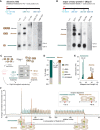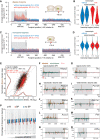Transcriptome-wide sites of collided ribosomes reveal principles of translational pausing
- PMID: 32703885
- PMCID: PMC7397865
- DOI: 10.1101/gr.257741.119
Transcriptome-wide sites of collided ribosomes reveal principles of translational pausing
Abstract
Translation initiation is the major regulatory step defining the rate of protein production from an mRNA. Meanwhile, the impact of nonuniform ribosomal elongation rates is largely unknown. Using a modified ribosome profiling protocol based on footprints from two closely packed ribosomes (disomes), we have mapped ribosomal collisions transcriptome-wide in mouse liver. We uncover that the stacking of an elongating onto a paused ribosome occurs frequently and scales with translation rate, trapping ∼10% of translating ribosomes in the disome state. A distinct class of pause sites is indicative of deterministic pausing signals. Pause site association with specific amino acids, peptide motifs, and nascent polypeptide structure is suggestive of programmed pausing as a widespread mechanism associated with protein folding. Evolutionary conservation at disome sites indicates functional relevance of translational pausing. Collectively, our disome profiling approach allows unique insights into gene regulation occurring at the step of translation elongation.
© 2020 Arpat et al.; Published by Cold Spring Harbor Laboratory Press.
Figures






References
Publication types
MeSH terms
Substances
LinkOut - more resources
Full Text Sources
Other Literature Sources
Molecular Biology Databases
